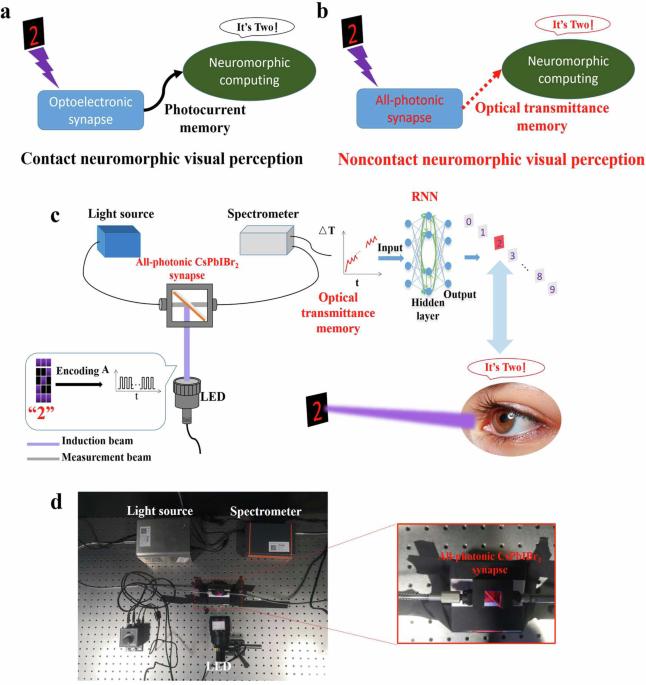All-photonic artificial synapses based on photochromic perovskites for noncontact neuromorphic visual perception
IF 7.5
Q1 MATERIALS SCIENCE, MULTIDISCIPLINARY
引用次数: 0
Abstract
Recently optoelectronic synapses generating light-driven electrical memories have played a vital role in the neuromorphic computing of visual perception. However, all the optoelectronic synapses demonstrate photoelectric conversion. Peripheral circuits are used for contact photocurrent measurement, leading to significant energy consumption and impeding the evolution of optical wireless communication. It is crucial to develop noncontact neuromorphic visual perception based on light-driven photonic memories. Herein, we report all-photonic artificial synapses based on photochromic perovskites. Triggered by ultraviolet and visible light pulses, cesium lead iodide bromine induces a structural disorder. Optical transmittance changes induced by the disorder last after the pulses are gone. Next, the photonic memories are propagated in the air and processed by a recurrent neural network. The accuracy of binary image recognition is instantly stabilized at 1.0, and accuracy above 0.8 after 7 epochs is achieved in the recognition of digitals from 0 to 9. The all-photonic synapses realize remote perception with zero in-situ energy consumption and enable artificial sensory systems with low-power computation, remote control, and ultrahigh propagation speed. Optoelectronic synapses are key to artificial visual perception systems based on neuromorphic computing, but they typically rely on photoelectric conversion and peripheral circuits that are energy consuming and prevent optical wireless communication. Here, all-photonic artificial synapses with light-driven optical transmittance memories are fabricated based on photochromic CsPbIBr2 perovskite thin films.

基于光致变色过氧化物的全光子人工突触,用于非接触式神经形态视觉感知
最近,产生光驱动电子记忆的光电突触在视觉感知的神经形态计算中发挥了重要作用。然而,所有光电突触都需要进行光电转换。外围电路用于接触式光电流测量,导致大量能源消耗,阻碍了光无线通信的发展。开发基于光驱动光子记忆的非接触式神经形态视觉感知至关重要。在此,我们报告了基于光致变色过氧化物的全光子人工突触。在紫外线和可见光脉冲的触发下,碘化铯铅溴会诱发结构紊乱。在脉冲消失后,由紊乱引起的光学透射率变化仍会持续。接下来,光子记忆在空气中传播,并由递归神经网络进行处理。二进制图像识别的准确度瞬间稳定在 1.0,而 0 至 9 的数字识别准确度在 7 个历时后达到 0.8 以上。全光子突触实现了零原位能耗的远程感知,并使人工感觉系统具备低功耗计算、远程控制和超高传播速度的能力。光电突触是基于神经形态计算的人工视觉感知系统的关键,但它们通常依赖于光电转换和外围电路,而光电转换和外围电路既耗能又妨碍光无线通信。在此,我们基于光致变色的 CsPbIBr2 包晶体薄膜,制造出了具有光驱动光透射存储器的全光子人工突触。
本文章由计算机程序翻译,如有差异,请以英文原文为准。
求助全文
约1分钟内获得全文
求助全文
来源期刊

Communications Materials
MATERIALS SCIENCE, MULTIDISCIPLINARY-
CiteScore
12.10
自引率
1.30%
发文量
85
审稿时长
17 weeks
期刊介绍:
Communications Materials, a selective open access journal within Nature Portfolio, is dedicated to publishing top-tier research, reviews, and commentary across all facets of materials science. The journal showcases significant advancements in specialized research areas, encompassing both fundamental and applied studies. Serving as an open access option for materials sciences, Communications Materials applies less stringent criteria for impact and significance compared to Nature-branded journals, including Nature Communications.
 求助内容:
求助内容: 应助结果提醒方式:
应助结果提醒方式:


